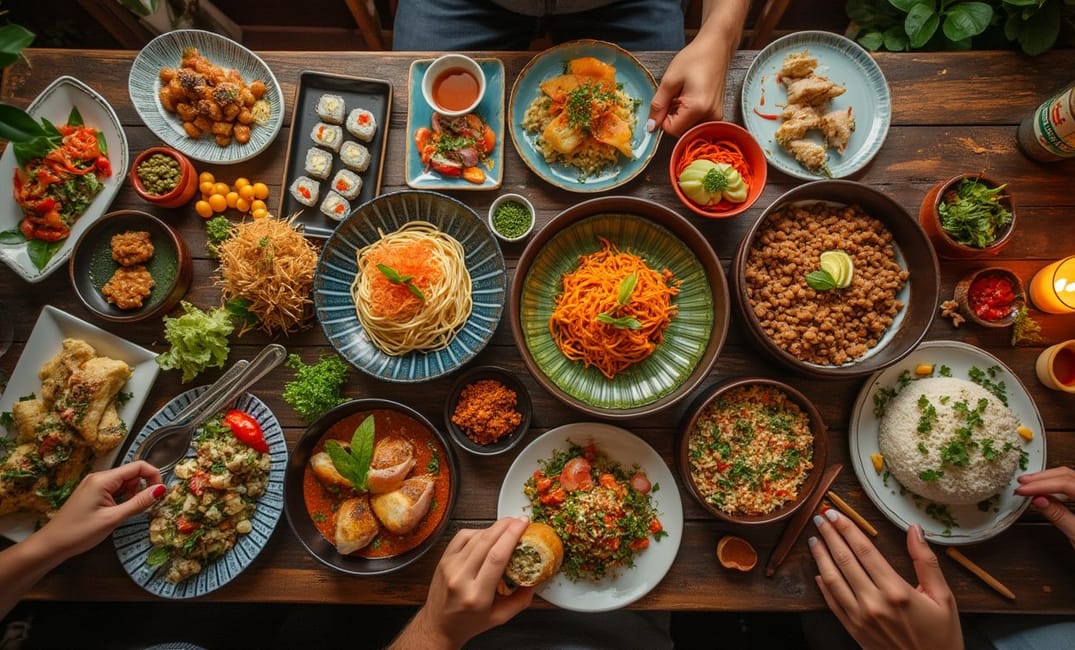Introduction: A Culinary Odyssey Across Continents
Food is not merely sustenance; it is a celebration of culture, an expression of identity, and a tactile link to traditions that have sustained societies over millennia. As humanity embarked on journeys across continents, the culinary landscape evolved in tandem with the migrations and settlements that defined each epoch of history. The rich tapestry of culinary traditions reveals more than flavors; it tells stories of the land, climate, agricultural practices, trade, and, importantly, the intricate social customs of communities. Today, we embark on a journey through the global culinary mosaic, exploring the delicate intricacies and diverse traditions that have enriched human experience.
The Ancient Culinary Prowess: From Flavors of Antiquity to Timeless Classics
Prehistoric Innovations: The Dawn of Cookery
- Harnessing Fire and Preservation Techniques: The mastery of fire heralded a pivotal shift in dietary practices, allowing early humans to experiment with roasting, smoking, and boiling techniques. These methods not only enhanced flavor but also extended food preservation, a necessity for nomadic tribes.
- Fermentation and Cultivated Cravings: Fermentation, one of the earliest forms of cooking, introduced flavors as pungent as cheese and as vital as beer. This alchemical process showcased early culinary innovation, relying on natural elements to increase food longevity and nutrient density.
Ancient Civilizations: Foundations of Classical Cuisine
- Egyptian Breadbaskets: Ancient Egypt's culinary prowess showcased intricately crafted bread, essential in both nutrition and ritual. Pyramids were often adorned with depictions of feastly offerings to sustain deities in their spiritual journeys, paralleling earthly devotion to grain cultivation.
- Roman Gastronomy and Culinary Arts: The Roman Empire’s gastronomical landscape was marked by epicurean indulgences, introducing sumptuous banquets known as "convivia," where dishes like garum—a fermented fish sauce—embodied decadence. Romans' culinary curiosity propelled imports of exotic spices, backbone of a thriving culinary economy.
Exploration, Exchange, and Fusion: The Spice-Driven Renaissance
The Silk Road: Exchange of Flavors and Innovation
- Spices That Changed the World: The Silk Road was a conduit for a vibrant array of spices—cinnamon, cardamom, and saffron—whose allure fueled culinary transformations across hemispheres. They transcended mere culinary uses, becoming crucial in medicine and religious ceremonies.
- Cross-Cultural Culinary Exchange: Through interactions along this vast network, culinary techniques—like Persian grilling or Indian tandoori baking—transcended cultures, enriching local cuisines with techniques and ingredients that fostered culinary diversity.
The Age of Exploration: New Horizons of Flavor
- Columbian Exchange and Global Palate Transformation: The Columbian Exchange reshaped the world's tables, seeing the global swap of livestock, crops, and culinary techniques. Tomatoes, chilies, cacao, and potatoes migrated across oceans, harmonizing with and diversifying regional cuisines.
- Fusion and Innovation: Shaping Modern Tastes: Culinary fusion forged during this era led to enduring staples—chili-infused hot chocolate as memorable as ceviche with citrus tang—showing the perennial power of cross-cultural culinary innovation to surprise and unite.
Culinary Traditions Through Cultural Lenses: A World of Taste
Asian Culinary Arts: Harmony and Philosophy
- Umami and Balance in Japanese Cuisine: Japanese gastronomy centers on the umami flavor, intertwining balance and aesthetics in every dish, be it sushi or miso soup. Its technique-intensive approach hinges on enhancing food's natural essence while celebrating mindful simplicity.
- Chinese Dim Sum and Dumplings: Dim Sum encapsulates the essence of Chinese culinary expression—a mosaic of textures, flavors, and regional diversities packaged within delicate parcels. These communal feasts epitomize China's diversity, where history and innovation converge at every bamboo steamer.
European Culinary Heritage: Tradition and Artistry
- French Haute Cuisine and Elegance: French cuisine stands as a paragon of culinary artistry, meticulous in technique and layered with sophistication. Its legacy is reflected in carefully curated dishes like Coq au Vin and the intricacies of pastry artistry, symbolizing culinary prestige.
- Italian Gastronomy: Passion and Simplicity: Italian cuisine is defined by its glorification of basic ingredients, transformed into culinary masterpieces through regional traditions. The humble art of pasta-making to the vibrant freshness of Insalata Caprese exemplifies Italy's culinary devotion.
The New World Flavors: Creativity and Resilience
- Mexican Cuisine: A Fusion of Tradition and Innovation: Rooted in ancient Mesoamerican traditions, Mexican cuisine is a flavorful blend of indigenous ingredients and Spanish influence. Corn, beans, and chili peppers are the holy trinity, sculpting dishes like mole with layers of historical narratives.
- Soul Food and the African American Tradition: Born from resilience in adversity, soul food stands testament to African American culinary ingenuity, with dishes like collard greens and cornbread marrying African culinary heritage with American southern elements.
Middle Eastern and African Culinary Junctions: Spice and Savory Encounters
- Middle Eastern Mezze: Social and Culinary Harmony: Hospitality is at the heart of Middle Eastern cuisine, beautifully illustrated in the social appetizers called mezze, where dishes like hummus and falafel take on communal significance amidst fragrant aromas and rich flavors.
- Sub-Saharan Africa's Rich Frugality: The diverse culinary map of Africa reflects resourcefulness under resilience, with staples like jollof rice and injera redefining simplicity harmonized with spices, encapsulating regional distinctiveness and inventive ecosystems of taste.
Modern Culinary Innovations: Science, Sustainability, and Social Stories
The Molecular Gastronomy Movement
- Innovations Born from Science and Art: Molecular gastronomy redefines limits of taste and perception, epitomized by luminaries turning culinary science into sensorial experiences. Techniques like spherification and emulsification bring enchanting dishes where taste transcends bounds.
- Redefining Culinary Principles: Fusion dishes exemplify creativity, fusing disparate culinary traditions and techniques—showcased in Japanese-Peruvian Nikkei cuisine—demonstrating how innovation within the culinary field is boundless and evolving.
Sustainability and Ethical Plate
- Plant-Based Revolution and Ethical Eating: Contemporary culinary trends emphasize sustainability and ethical considerations, promoting plant-based diets and conscious sourcing as imperatives for ecological balance.
- Urban Farming and Culinary Resilience: As urbanization sprawls, culinary practices reimagined within city confines leverage rooftop gardens and community food initiatives, ensuring heritage and freshness amidst shrinking spaces.
Technology's Taste: The Digital Culinary Sphere
- Social Media and Global Home Cooking: Platforms showcase and democratize culinary practices, turning global kitchens into interconnected cultural forums, facilitating cross-pollination of recipes and collaboratively piecing together new traditions.
- Emergence of Digital Chefs and Cookbook Evolution: Innovations like augmented reality recipes and interactive food blogs revolutionize culinary pedagogy, bridging tradition and burgeoning technology for a holistic embrace of modernity.
Conclusion: The Infinite Feast of Humanity
Culinary traditions, a testament to human adaptability, are an embodiment of cultural persistence and a celebration of humanity's unyielding creativity and connectivity. As we savor the flavors of ancient innovations alongside those borne of modern ingenuity, the infinite culinary feast reveals more than a pathway of nourishment; it unveils stories of community, bridging generations and borders.
"Every dish is a story waiting to be told—an edible history seamlessly blending the past and present, where flavors narrate humanity's unending journey through time and culture."
COOKING TECHNIQUES, HISTORY, CULTURE, CULINARY ARTS, FUSION CUISINE, INNOVATION, GLOBAL CUISINE, GASTRONOMY, FOOD HISTORY, CULINARY TRADITIONS

